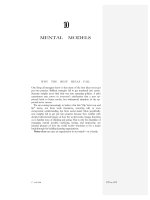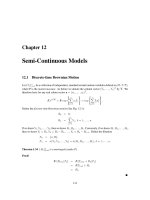MENTAL MODELS
Bạn đang xem bản rút gọn của tài liệu. Xem và tải ngay bản đầy đủ của tài liệu tại đây (311.06 KB, 31 trang )
17. září 2004
159 ze 412
10
MENTAL MODELS
WHY THE BEST IDEAS FAIL
One thing all managers know is that many of the best ideas never get
put into practice. Brilliant strategies fail to get translated into action.
Systemic insights never find their way into operating policies. A pilot
experiment may prove to everyone's satisfaction that a new ap-
proach leads to better results, but widespread adoption of the ap-
proach never occurs.
We are coming increasingly to believe that this "slip 'twixt cup and
lip" stems, not from weak intentions, wavering will, or even
nonsystemic understanding, but from mental models. More specifically,
new insights fail to get put into practice because they conflict with
deeply held internal images of how the world works, images that limit
us to familiar ways of thinking and acting. That is why the discipline of
managing mental models—surfacing, testing, and improving our
internal pictures of how the world works—promises to be a major
breakthrough for building learning organizations.
None of us can carry an organization in our minds—or a family,
17. září 2004
160 ze 412
or a community. What we carry in our heads are images, assumptions,
and stories. Philosophers have discussed mental models for centuries,
going back at least to Plato's parable of the cave. "The Emperor's
New Clothes" is a classic story, not about fatuous people, but about
people bound by mental models. Their image of the monarch's dignity
kept them from seeing his naked figure as it was.
In surveying the accomplishments of cognitive science in his book
The Mind's New Science, Howard Gardner writes, "To my mind, the
major accomplishment of cognitive science has been the clear
demonstration of. . . a level of mental representation" active in
diverse aspects of human behavior.
1
Our "mental models" determine
not only how we make sense of the world, but how we take action.
Harvard's Chris Argyris, who has worked with mental models and
organizational learning for thirty years, puts it this way: "Although
people do not [always] behave congruently with their espoused
theories [what they say], they do behave congruently with their
theories-in-use [their mental models]."
2
Mental models can be simple generalizations such as "people are
untrustworthy," or they can be complex theories, such as my as-
sumptions about why members of my family interact as they do. But
what is most important to grasp is that mental models are active— they
shape how we act. If we believe people are untrustworthy, we act
differently from the way we would if we believed they were
trustworthy. If I believe that my son lacks self-confidence and my
daughter is highly aggressive, I will continually intervene in their
exchanges to prevent her from damaging his ego.
Why are mental models so powerful in affecting what we do? In part,
because they affect what we see. Two people with different mental
models can observe the same event and describe it differently,
because they've looked at different details. When you and I walk into
a crowded party, we both take in the same basic sensory data, but we
pick out different faces. As psychologists say, we observe selectively.
This is no less true for supposedly "objective" observers such as
scientists than for people in general. As Albert Einstein once wrote,
"Our theories determine what we measure." For years, physicists ran
experiments that contradicted classical physics, yet no one "saw" the
data that these experiments eventually provided, leading to the
revolutionary theories—quantum mechanics and relativity—of
twentieth-century physics.
3
The way mental models shape our perceptions (is no less important in
management. For decades, the Big Three of Detroit believed that
17. září 2004
161 ze 412
people bought automobiles on the basis of styling, not for quality of
reliability. Judging by the evidence they gathered, the automaker*
were right. Surveys and buying habits consistently suggested that;
American consumers cared about styling much more than abou^
quality. These preferences gradually changed, however, as German and
Japanese automakers slowly educated American consumers ii the
benefits of quality and style—and increased their share of thf U.S.
market from near zero to 38 percent by 1986." According t<$
management consultant Ian Mitroff, these beliefs about styling we™
part of a pervasive set of assumptions for success at General Md|
tors:
5
GM is in the business of making money, not cars.
Cars are primarily status symbols. Styling is therefore more im-i
portant than quality.
The American car market is isolated from the rest of the world.
Workers do not have an important impact on productivity or prod-
uct quality.
Everyone connected with the system has no need for more than a
fragmented, compartmentalized understanding of the business.
As Mitroff pointed out, these principles had served the industry
well for many years. But the auto industry treated these principles as
"a magic formula for success for all time, when all it had found was a
particular set of conditions . . . that were good for a limited time."
The problems with mental models lie not in whether they are right
or wrong—by definition, all models are simplifications. The problems
with mental models arise when the models are tacit—when they exist
below the level of awareness. The Detroit automakers didn't say, "We
have a mental model that all people care about is styling." They said,
"All people care about is styling." Because they remained unaware of
their mental models, the models remained unex-amined. Because they
were unexamined, the models remained unchanged. As the world
changed, a gap widened between Detroit's mental models and reality,
leading to increasingly counterproductive actions.
6
As the Detroit automakers demonstrated, entire industries can
develop chronic misfits between mental models and reality. In some
ways, close-knit industries are especially vulnerable because all the
member companies look to each other for standards of best practice.
17. září 2004
162 ze 412
Such outdated reinforcement
of mental models occurred in many
basic U.S. manufacturing industries, not just automobiles, throughout
the 1960s and 1970s. Today, similar outdated mental models dominate
many service industries, which still provide mediocre quality in the
name of controlling costs. (See Chapter 17, "Micro-worlds," for an
example.)
Failure to appreciate mental models has undermined many efforts to
foster systems thinking. In the late 1960s, a leading American
industrial goods manufacturer—the largest in its industry—found
itself losing market share. Hoping to analyze their situation, top
executives sought help from an MIT team of "system dynamics"
specialists. Based on computer models, the team concluded that the
firm's problems stemmed from the way its executives managed in-
ventories and production. Because it cost so much to store its bulky,
expensive products, production managers held inventories as low as
possible and aggressively cut back production whenever orders
turned down. The result was unreliable and slow delivery, even
when production capacity was adequate. In fact, the team's computer
simulations predicted that deliveries would lag further during business
downturns than during booms—a prediction which ran counter to
conventional wisdom, but which turned out to be true.
Impressed, the firm's top executives put into effect a new policy
based on the analysts' recommendations. From now on, when orders
fell, they would maintain production rates and try to improve delivery
performance. During the 1970 recession, the experiment worked;
thanks to prompter deliveries and more repeat buying from satisfied
customers, the firm's market share increased. The managers were so
pleased that they set up their own systems group. But the new policies
were never taken to heart, and the improvement proved temporary.
During the ensuing business recovery, the managers stopped worrying
about delivery service. Four years later, when the more severe OPEC-
induced recession came, they went back to their original policy of
dramatic production cutbacks.
Why discard such a successful experiment? The reason was the
mental models deeply embedded in the firm's management traditions.
Every production manager knew in his heart that there was no more
sure-fire way to destroy his career than to be held responsible for
stockpiling unsold goods in the warehouse. Generations of top
management had preached the gospel of commitment to inventory
control. Despite the new experiment, ihe^oldmental model was still
alive and well.
The inertia of deeply entrenched mental models can overwhelm
17. září 2004
163 ze 412
even the best systemic insights. This has been a bitter lesson for
many a purveyor of new management tools, not only for systems
thinking advocates.
But if mental models can
impede
learning—freezing companies and
industries in outmoded practices—why can't they also help
ac*< celerate
learning? As it happens, several organizations, largely ops erating
independently, have given serious attention to this question! in recent
years.
INCUBATING A NEW
BUSINESS WORLDVIEW
Perhaps the first large corporation to discover the potential power of
mental models in learning was Royal Dutch/Shell. Managing a highly
decentralized company through the turbulence of the world oil business
in the 1970s, Shell discovered that, by helping managers clarify their
assumptions, discover internal contradictions in those assumptions,
and think through new strategies based on new assumptions they
gained a unique source of competitive advantage.
Shell is unique in several ways that have made it a natural environ-
ment for experimenting with mental models. It is truly multicultural,
formed originally in 1907 from a "gentleman's agreement" between
Royal Dutch Petroleum and the London-based Shell Transport and
Trading Company. Royal Dutch/Shell now has more than a hundred!
operating companies around the world, led by managers from almost as
many different cultures.
The operating companies enjoy a high degree of autonomy and
local independence. From its beginning, Shell managers had to learn to
operate by consensus, because there was no way these "gentlemen"
from different countries and cultures would be able to tell each other
what to do. As Shell grew and became more global and more
multicultural, its needs for building consensus across vast gulfs of
style and understanding grew.
In the turbulent early 1970s, Shell's tradition of consensus man-
agement was stretched to the breaking point. What emerged was a
new understanding of the underpinnings of real consensus—an un-
derstanding of shared mental models. "Unless we influenced the
mental image, the picture of reality held by critical decisionmakers, our
scenarios would be like water on a stone," recalled Shell's former
senior planner Pierre Wack, in his seminal
Harvard Business
17. září 2004
164 ze 412
Review
articles about the Shell mental models work.
7
Wack had come
to this realization in 1972, as he and his colleagues desperately faced
their failure to convey to Shell's managers the "discontinuities" they
foresaw in the world oil market.
That was the year before OPEC and the onset of the energy crisis.
After analyzing long-term trends of oil production and consumption,
Wack had concluded that the stable, predictable world familiar to
Shell's managers was about to change. Europe, Japan, and the U.S.
were becoming increasingly dependent on oil imports. Oil-exporting
nations such as Iran, Iraq, Libya, and Venezuela were becoming
increasingly concerned with falling reserves. Others, such as Saudi
Arabia, were reaching the limits of their ability to productively invest oil
revenues. These trends meant that the historical, smooth growth in
oil demand and supply would eventually give way to chronic supply
shortfalls, excess demand, and a "seller's market" controlled by the
oil-exporting nations. While Shell's planners did not predict OPEC
exactly, they foresaw the types of changes that OPEC would eventualy
bring about. Yet, attempts to impress upon Shell's managers the
radical shifts ahead had led "no more than a third of Shell's critical
decision centers" to act on the new insights.
In principle, Shell's "Group Planning" staff were in an ideal posi-
tion to disseminate insights about the changes ahead. Group
Planning was the central planning department, responsible for coor-
dinating planning activities in operating companies worldwide. At the
time, Group Planning was developing a new technique called
"scenario planning," a method for summarizing alternative future
trends. The planners at Shell began to build in the coming discontin-
uities into their scenarios. But their audience of Shell managers
found these new scenarios so contradictory to their years of experi-
ence with predictable growth that they paid little attention to them.
At this point, Wack and his colleagues realized that they had fun-
damentally misperceived their task. From that moment, Wack
wrote, "We no longer saw our task as producing a documented view of
the future . . . Our real target was the 'microcosms' "—Wack's word
for mental models—"of our decision makers . . . We now wanted to
design scenarios so that managers would question their own model of
reality and change it when necessary." If the planners had once thought
their job was delivering information to the decision makers, it was now
clear that their task was to help managers rethink their worldview. In
particular, the Group PISnrlers developed a new set of scenarios in
January-February 1U/3 which forced the man-
17. září 2004
165 ze 412
agers to identify all of the assumptions that had to be true in order
for the managers' "trouble-free" future to occur. This revealed a set
of assumptions only slightly more likely to come true than a fairy
tale.I
Group Planning now built a new set of scenarios, carefully dl
signed to take off from the current mental models of Shell manage!!
They showed how the prevailing view that "the oil business would
continue as usual" was based on underlying assumptions about
m
nature of global geopolitics and the oil industry; then they showed that
these assumptions could not possibly hold in the future that
was
coming. Then they helped managers begin the process of construct-
ing a new mental model—by helping them think through how the,
would have to manage in this new world. For example, exploration for
oil would have to expand to new countries, while refinery build ing
would have to slow down because of higher prices and conse- quently
slower demand growth. Also, with greater instability nations would
respond differently. Some, with free-market tradi- tions, would let the
price rise freely; others with controlled-market policies, would try to
keep it low. Thus, control to Shell's locally based operating companies
would have to increase to enable them to adapt to local conditions.
Although many Shell managers remained skeptical, they took the
new scenarios seriously because they began to see that their present
understandings were untenable. The exercise had begun to unfreeze
managers' mental models and incubate a new world view.
When the OPEC oil embargo suddenly became a reality in the
1
winter of 1973-74, Shell responded differently from the other oi|
companies. They slowed down their investments in refineries, and]
designed refineries that could adapt to whatever type of crude oil was
available. They forecast energy demand at a consistently lower) level
than their competitors did, and consistently more accurately. They
quickly accelerated development of oil fields outside OPEC.
While competitors reined in their divisions and centralized control
—a common response to crisis—Shell did the opposite. This gave
their operating companies more room to maneuver while their com-
petitors had less.
Shell's managers saw themselves entering a new era of supply
shortages, lower growth, and price instability. Because they had
come to expect the 1970s to be a decade of turbulence (Wack called it
the decade of "the rapids"), they responded to the turbulence
effectively. Shell had discovered the power of managing mental
models.
17. září 2004
166 ze 412
1 The net result of Shell's efforts was nothing short of spectacular. In
1970, Shell had been considered the weakest of the seven largest toil
companies. Forbes called it the "Ugly Sister" of the "Seven Bisters."
By 1979 it was perhaps the strongest; certainly it and ■xxon were in
a class by themselves.
8
By the early 1980s, articulat-Wtg managers'
mental models was an important part of the planning ■rocess at Shell.
About a half-year prior to the collapse of oil prices ■I 1986, Group
Planning, under the direction of coordinator Arie de Beus, produced a
fictitious Harvard Business School-style case Study of an oil company
coping with a sudden world oil glut. Man-■gers had to critique the oil
company's decisions. Thus, once again, ■hey prepared themselves
mentally for a reality which the planners ■lispected they might have to
face.
I OVERCOMING "THE BASIC
I DISEASES OF THE HIERARCHY"
f'In the traditional authoritarian organization, the dogma was man-
Etging, organizing, and controlling," says Hanover's CEO Bill
PO'Brien. "In the learning organization, the new 'dogma' will be vi-
' sion, values, and mental models. The healthy corporations will be
ones which can systematize ways to bring people together to develop
the best possible mental models for facing any situation at hand."
O'Brien and his colleagues at Hanover have come to their interest in
mental models over a journey comparable in length to Shell's, but
dramatically different in almost every other way.
Hanover was originally founded in 1852. As noted earlier, it has
gone from near-bankruptcy in 1969, when it was acquired by the
State Mutual company, to one of the best performing companies in
the property and casualty industry today. At $1.5 billion in annual
premium sales, Hanover handles only one tenth of the volume of an
industry giant such as Aetna, but its compound rate of return since
1980 has been 19 percent, which ranks sixteenth among sixty-eight
insurance companies surveyed by Forbes in January 1990.
Beginning in 1969, Hanover took on a long-term mission to revamp
the traditional hierarchical values that had dominated the organization
for so long. "We set out," says O\Brien, "to find what would give the
necessary organization and discipline to have work be more congruent
with human nature. We gradually identified a set of core values that are
actually principles that overcome the basic diseases of the hierarchy."
17. září 2004
167 ze 412
Two of these values in particular, "openness” and "merit," led
Hanover to develop its approach to managing mental models. Open-
ness was seen as an antidote to what O'Brien called "the disease of
gamesplaying that dominated people's behavior in face-to-face meetings.
Nobody described an issue at 10:00 in the morning at a business meeting
the way they described the issue at 7:00 that evening, at home or
over drinks with friends." Merit—making decisions based on the best
interests of the organization—was Hanover's antidote to
"decisionmaking based on bureaucratic politics, where the name of the
game is getting ahead by making an impression, or, if you're already at
the top, staying there."
9
As openness and merit took hold, a deep belief
evolved from them: that decision-making processes could be
transformed if people become more able to surface and discuss
productively their different ways of looking at the world. But if this was
so useful why did it seem so difficult?
In the mid-1970s, the ideas of Argyris and his colleagues were
beginning to provide an answer. In "action science," they were
developing a body of theory and method for reflection and inquiry on
the reasoning that underlies our actions.
10
Moreover, the tools of action
science are designed to be effective in organizations, and especially in
dealing with organizational problems. We trap ourselves, say Argyris
and his colleagues, in "defensive routines" that insulate our mental
models from examination, and we consequently develop "skilled
incompetence"—a marvelous oxymoron that Argyris uses to describe
most adult learners, who are "highly skillful at protecting themselves
from pain and threat posed by learning situations," but consequently
fail to learn how to produce the results they really want.
Despite having read much of his writing, I was unprepared for
what I learned when I first saw Chris Argyris practice his approach in
an informal workshop with a half-dozen members of our research team
at MIT. Ostensibly an academic presentation of Argyris's methods, it
quickly evolved into a powerful demonstration of what action science
practitioners call "reflection in action." Argyris asked each of us to
recount a conflict with a client, colleague, or family member. We had
to recall not only what was said, but what we were thinking and did
not say. As Chris began to "work with these cases it became almost
immediately apparent how each of us contributed to a conflict through
our own thinking—how we made sweeping generalizations about the
others that determined what we said and how we behaved. Yet, we
never communicated the gener-
17. září 2004
168 ze 412
alizations. I might think, "Joe believes Tin incompetent," but I
would never ask Joe directly
about
it. I would simply go out of my
way to try
continually to make myself look respectable to
Joe.
Or,"Bill
[my boss] is impatient and believes in quick and dirty solu-
tions," so I go out of my way to give him simple solutions even
though I
don't think they will really get to the heart of difficult issues.
Within a matter of minutes, I watched the level of alertness and
"presentness" of the entire group rise ten notches—thanks not so
much to Argyris's personal charisma, but to his skillful practice of
drawing out those generalizations. As the afternoon moved on, all of us
were led to see (sometimes for the first time in our lives) subtle
patterns of reasoning which underlay our behavior; and how those
patterns continually got us into trouble. I had never had such a
dramatic demonstration of my own mental models in action, dictating
my behavior and perceptions. But even more interesting, it became
clear that, with proper training, I could become much more aware of
my mental models and how they operated. This was exciting.
Later I learned that O'Brien and his management team at Hanover
had had a similar experience with Argyris's methods ten years earlier.
This had led them to realize that, in O'Brien's words, "Despite our
philosophy we had a very long way to go to being able to have the
types of open, productive discussion about critical issues that we all
desired. In some cases, Argyris' work revealed painfully obvious
gamesplaying that we had come to accept. Chris held an incredibly
high standard of real openness, of seeing our own thinking and cutting
the crap. Yet, he was also not simply advocating "tell everyone
everything"—he was illustrating the skills of engaging difficult issues
so that everyone learned. Clearly, this was important new territory if
we were really going to live our core values of openness and merit."
Working with Argyris's colleague Lee Bolman, also of Harvard,
Hanover eventually developed a three-day management seminar,
called "Merit, Opennness, and Localness," intended to expose all
Hanover managers to the basic ideas and practices of action science.
These seminars have been attended by virtually all of Hanover's
middle and upper management over the past ten years. The basic
purpose of the seminars is to extend the practice of these three core
values by showing the skills needed^ttKput them into practice. As
Paul Stimson, the manager currently in charge of the seminar puts it,
"Our first task is to get people to start to appreciate what it means
17. září 2004
169 ze 412
to practice merit, openness, and localness in a learning organization. In
traditional organizations, merit means doing what the boss wants,
openness means telling the boss what he wants to hear, and localness
means doing the dirty stuff that the boss doesn't want to do. So, we have
a long way to go in getting people to some new understandings."
The first day is spent reviewing the basic concepts, principles, and
skills of action science. Most find this enlightening but hardly earth-
shaking. "Yes, of course, I agree with this. I always try very hard to be
a good inquirer" is a typical response at the end of Day 1. The lights
start to go on in Day 2, when Stimson and his colleagues video tape the
managers attempting to apply the skills in role-playing exercises. Before
their role-playing, the managers identify particular skills they want to
work on. For example, a manager in a performance review role-play
might want to work on "balancing inquiry and advocacy" (taking a
position but also inquiring into others' views and remaining open).
But within a few minutes of starting the role-play, the very same
manager will be pointing his finger at the subordinate and preaching
rather than listening. "When everyone watches the tapes together
afterward," Stimson says, "it is often hilarious to see how much our
own behavior deviates from what we say we do. People see that there
is much more to putting action science skills into practice than merely
nodding in agreement."
The three-days of the MOL seminar are hardly enough to become
masters in the skills of action science, but the very personal exposure
and initial opportunity to practice with a group of fellow learners
starts a process that continues "back home." Perhaps, equally
important, it shows Hanover's seriousness about approaching the
mental models discipline as a set of developable skills, not as vague
generalities and pieties about "thinking more effectively."
Convinced that there was a payoff in helping managers improve
their basic thinking skills, Hanover later supported a second manage-
ment training to, as O'Brien puts it, "expose the limitations of
'mechanistic thinking.' The problem we saw was the tendency of
managers to confront complex business issues with '9-point pro-
grams,' as if the problem was fixing a flat tire. This usually results in
making problems worse." This second training program, "Thinking
about Thinking," was designed and delivered by a retired University of
New Hampshire professor, John Beckett. Beckett leads an exhaustive,
and surprisingly not exhausting, historical survey of major
philosophies of thought, East and West, over five
full
days. In a
17. září 2004
170 ze 412
process Beckett describes as "sandpaper on the brain," he shows in
great detail how radically differing philosophies all have merit.
The impact of the Beckett program is striking. "Beckett shows,"
says O'Brien, "that if you look closely at how Eastern cultures ap-
proach basic moral, ethical, and managerial issues, they do make
sense. Then he shows that Western ways of approaching these issues
also make sense. But the two can lead to opposite conclusions. This
leads to discovering that there is more than one way to look at
complex issues. It helps enormously in breaking down the walls
between the disciplines in our company, and between different ways of
thinking."
The impact on managers' understanding of mental models is pro-
found—most report that they see for the first time in their life that
all we ever have are assumptions, never "truths," that we always see
the world through our mental models and that the mental models are
always incomplete, and, especially in Western culture, chronically
nonsystemic. While Beckett does not provide tools for working with
mental models as Argyris does, he plants a powerful seed that leaves
people more open to seeing the inevitable biases in their own ways of
thinking. Beckett also introduces people to basic principles of systems
thinking. In particular, he emphasizes the distinction between "process
thinking" and seeing only "snapshots," and poses systems thinking as a
philosophical alternative to the pervasive ' 're-ductionism" in Western
culture—the pursuit of simple answers to complex issues.
How has this substantial investment in developing skills and ap-
preciation of mental models returned benefits for Hanover's manage-
ment? O'Brien and others simply point to Hanover's steadily
improving performance over the years: in profitability, Hanover was
better than the industry average three out of five times from 1970-74,
four out of five times in 1975-79, and ten out of ten years in 1980-89;
in growth, Hanover bested the industry average one out of five times in
1970-74, four out of five times in 1975-79, eight out of ten times in
1980-89. From 1985-89, Hanover's average return on equity was 19.8
percent compared with 15.9 percent for the property and liability
industry, and its sales growth was 21.8 percent compared with 15
percent for the industry. Anessay in their 1988 annual report on "The
Connection Between Learning and Competitiveness" asserts that the
firm's commitment to "invest in education during good times and
during bad times" has resulted in reaping benefits continuously.









